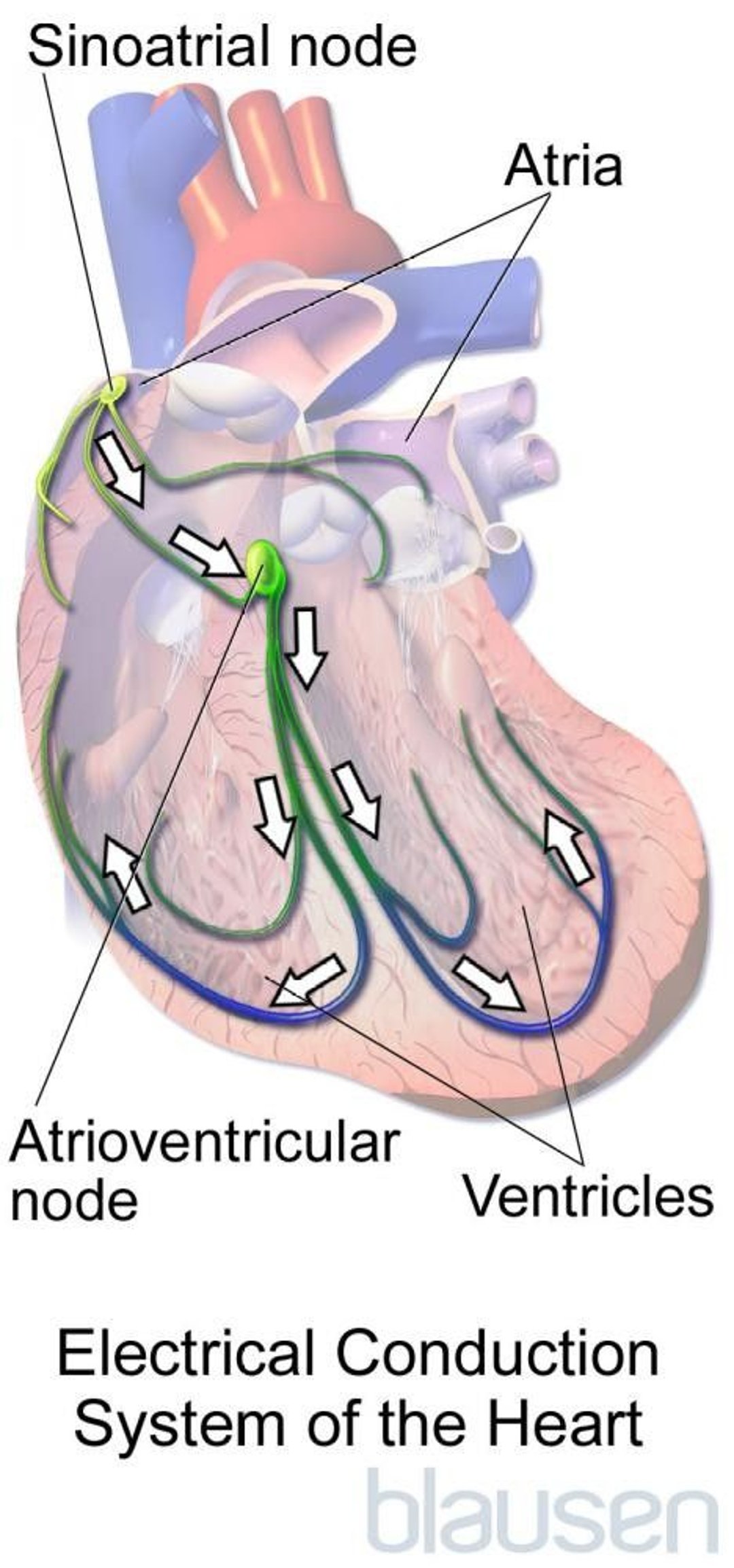Your heart is a muscle that pumps blood through your body. Your heart rate is how fast your heart beats. Your heart should always have a regular, rhythmic beat, like the ticking of a clock.
Your heart has four chambers. The atria are the two upper chambers. The ventricles are the two lower chambers. The atria pump blood into the ventricles. The ventricles pump blood to your lungs and your body (see also Biology of the Heart).
Special pacemaker cells in a part of the atria called the SA node (sinoatrial node) send out regular electrical signals to your heart muscle to make it contract.
Your heart's conduction system has tiny strips of tissue sort of like electrical wires. The conduction system carries the pacemaker signals to the rest of your heart. The signals must get to all your heart muscle cells at just the right time so your heart gives a good, strong beat that pumps blood properly.
What are atrial fibrillation and atrial flutter?
Atrial fibrillation and atrial flutter are types of abnormal heart rhythms. They're caused by an abnormal electrical pattern in the heart.
In atrial fibrillation, the cells in the atria don't send out regular electrical signals. Instead, there's a lot of random electrical activity that makes the upper compartments (atria) of your heart quiver instead of squeeze strongly in a regular rhythm. Some of this random activity passes to the ventricles, which beat irregularly up to 140 to 160 times per minute instead of the normal 60 to 100 regular beats per minute.
In atrial flutter, the cells in the atria send out regular signals, but the signals get caught in a loop that goes round and round. The looping electrical signal makes the atria beat regularly but very quickly, about 250 to 350 times per minute. Usually only about half of these abnormal beats pass through to your ventricles, which then beat at 125 to 175 times per minute.
Both atrial fibrillation and atrial flutter make it harder for your heart to pump blood
You may notice changes to your heartbeat (palpitations) and feel weak or short of breath
High blood pressure, heart disease, or a birth defect can cause atrial fibrillation or atrial flutter
Doctors treat atrial fibrillation and atrial flutter with medicines and sometimes an electrical shock (cardioversion) or an ablation procedure
What causes atrial fibrillation and atrial flutter?
They are often caused by:
Coronary artery disease (when a blood vessel that supplies blood and oxygen to your heart is narrowed or blocked)
Drinking too much alcohol
Hyperthyroidism (when your thyroid puts out too much thyroid hormones)
Problems with your heart valves and high blood pressure cause your atria to get bigger. This makes atrial fibrillation or atrial flutter more likely.
Atrial fibrillation and atrial flutter can also happen in people without any other heart problems.
What are the symptoms of atrial fibrillation and atrial flutter?
You may have no symptoms, or you may feel:
Unpleasant awareness of your heartbeat (palpitations), which may feel like pounding, fluttering, racing, or skipping beats
Chest discomfort
Weakness
Faintness
Shortness of breath
What are the complications of atrial fibrillation and atrial flutter?
Atrial fibrillation and atrial flutter can cause:
Blood clots in the atria, which can travel from your heart to your brain and cause a stroke
Rapid heart rate, which can lead to a drop in blood pressure and heart failure
How can doctors tell if I have atrial fibrillation and atrial flutter?
Doctors feel your pulse and do:
An ECG is a quick, painless test that measures your heart’s electrical activity using stickers and cables on your chest, arms, and legs.
If the ECG shows atrial fibrillation or atrial flutter, doctors usually do other tests including:
Blood tests to check hormone and electrolyte levels
Echocardiography (ultrasound of your heart)
How do doctors treat atrial fibrillation and atrial flutter?
Doctors treat the disorder causing your heart rhythm problem.
The most important treatment goals are to:
Keep your heart rate from being too fast
Prevent blood clots in your heart
Sometimes, return your heart to a normal rhythm
Treatments often include:
Blood-thinning medicine to prevent blood clots
Medicine to slow down your heart
Sometimes, medicine or an electrical shock (cardioversion) to return your heart to a normal rhythm
Sometimes, an ablation procedure to destroy abnormal heart tissue
What's an ablation procedure?
Doctors first do electrophysiologic testing, which is like cardiac catheterization. Doctors insert a thin flexible tube (catheter) into a large blood vessel (for example, in your leg) and thread it up to your heart. The catheter has electrodes on its tip that record your heart's electrical activity from the inside. The catheter can also stimulate your heart electrically to see how it responds.
If the test shows that one small bit of heart tissue is causing the atrial fibrillation, getting rid of the tissue often fixes the rhythm problem. Doctors use a catheter that delivers a high-frequency electrical current to destroy the tissue that's causing the problem.

